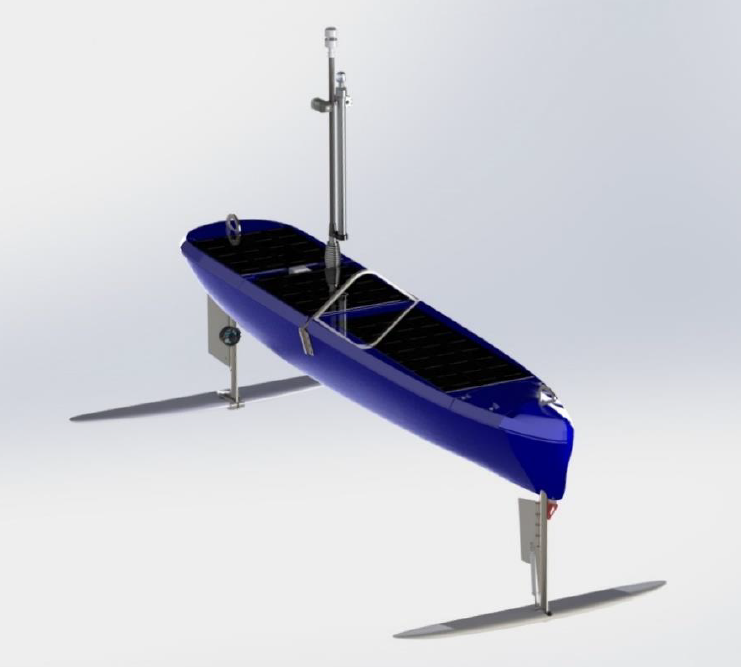
Objectives of the service
This project puts forward a unmanned surface vessel for gathering data from sea-bed assets by underwater acoustic communications.
Sub-sea assets are commonly installed with sensors for long term monitoring roles by the oil and gas, defence and marine science sectors. The valuable data acquired by these sensors must be uploaded from these untethered assets, through the water column, by acoustic communications. Often located in remote and challenging offshore environments, a conventional vessel is currently required to acquire this data. This method involves high costs, high safety risks and high carbon emissions.
Our concept is to operate an unmanned surface vessel at sea over many, wholly powered by wave and solar energy. The AutoNaut USV would transit to remote sites and precisely hold station at the sea surface above the data upload station. Equipped onboard with compatible acoustic communications technology, the valuable data would be “harvested” by the AutoNaut for storage onboard and/ or relay back to shore. The endurance USV then moves on to its next upload point.
Objectives are to provide service to customers by delivering the same data quality and quantity with higher safety standards and significantly reduced costs.
Service/ system concept
Interest has been identified in defence, marine science and oil and gas.
Oil and gas majors are the most targeted as high value potential customers. Projects in the oil and gas sector however are likely to involve service provider companies. Such companies often operate on behalf of major clients so are also potentially direct customers. Having worked with a range if technologies, such companies invariably have the most experience as end users. There is potential in some instances for this to be competitive with our product/service. Close collaboration, both technical and commercial, is possibility in this context - and this study has helped establish and further good relationships. Experts in the field, including suppliers of acoustic communications technology were also consulted in the stakeholder engagement stage.
The user needs are to:
- Reduce logistical problems – principally from reliance on vessels of opportunity
- Reduce safety risks of personnel working offshore
- Reduce environmental impact
- Assure data quantity
- Assure data quality
- Ensure compatibility of A-Comms equipment
To meet these needs a range of identified challenges must be overcome, including; technical, operational, safety assurance, financial and resourcing. Crucially, clear cost-benefit most be shown.
UK, Norway, USA.
Space Added Value
The proposed system is an AutoNaut 3.5-metre unmanned surface vessel (USV) The USV is wholly renewably powered; propelled forward by wave energy with sensors and electronics powered by solar energy. This enables long-term mission duration anywhere in the world without personnel at sea. Missions are pre-programmed for AutoNaut to follow set transects or hold station. Fully trained remote operators oversee incoming data and are able to change course or modify tasks. AutoNaut itself is equipped with the latest safety systems and is fully compliant with appropriate international marine standards and regulations.
Onboard the USV shall be equipped with compatible acoustic communications technology. The valuable data would be “harvested” by the AutoNaut for storage onboard and/ or relay back to shore.

Schematic of AutoNaut 3.5 metre
The service will be provision of data to the client on a more regular and frequent basis. In terms of management and delivery of this data, such as from sensors placed on decommissioned well-head for monitoring of pressure, there is potential to offer services of quality control, partial or fully processing of the data.
Completing over-the-horizon missions at sea by the AutoNaut unmanned surface vessel would not be possible without satellite assets. GNSS and Iridium Rudics are essential for positioning, navigation, timing and communications.
Satellite Navigation GNSS: GNSS systems are essential for position, navigation and timing. The USV is operated, tasked and monitored through the use of a satellite based real time situational awareness platform. Command and control of the boat is conducted from the safety of shore. Remote operators need to constantly track location and GPS is vital for the setting of pre-programmed waypoints to be followed. Accurate positioning is essential not only for safe navigation and operation of the USV but also for sub-sea applications where an accurate geo-reference at the surface is required.
Satellite Comms: Global, low bandwidth transfer via Iridium RUDICS is vital to enable endurance missions of many weeks in remote locations at sea. Iridium RUDICS relays command, control and diagnostic information to and from the unmanned surface vessel. Low bandwidth and occasional drop-out is overcome with data duty cycling and adjustable delivery. Other methods available (WiFi, UHF and GSM) as an alternative only work when in range – for the proposed applications, this is rare. Packets of data transmitted from the USV, fully or partially processing onboard depending on data type, can be transferred in near real time to shore based analysts and/or the client. This data transfer over satellite communications provides oversight of data quality and ensures all systems operate at optimal performance.
Operation of the proposed activities would not be possible without space technology and assets. Value is further added by safety assurance and timely data delivery to the client. Once developed, the full service intends to provide benefits in; data quantity and quality, safety – by removing personnel from the offshore environment, reduced environmental impact and significant cost savings relative to current methods.
Current Status
A formal kick-off meeting was held on 26th June 2019 confirming responsibilities, work packages and scheduling. For stakeholder engagement, various meetings and conversations have taken place with end-users. This has included technical experts in the field and key potential clients. Knowledge acquired has been captured in the User Requirements Review and this document is now being finalised. Existing technologies and operational solutions have been under assessment and technical work on the system architecture has initiated.


